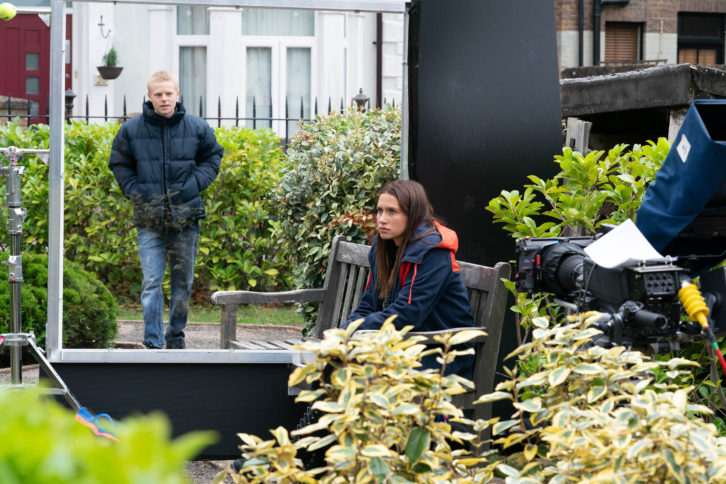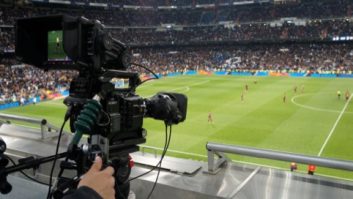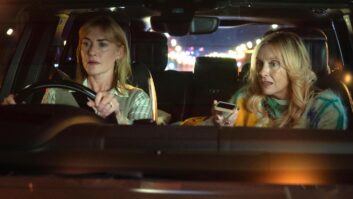EastEnders was forced to cease production on 17th March because of restrictions in place due to the Covid-19 pandemic. But, as restrictions were lifting, the cast and crew were able to return to BBC Elstree on 29th June to start producing the popular BBC soap. The first episode from this new season will be aired on Monday 7th September at 8.05pm.
“It was realty exciting to get back after lockdown and begin work on shooting amazing episodes,” reports executive producer, Jon Sen. “When the lockdown was introduced, I spent time thinking over how we could overcome the restrictions and yet produce the same quality of production with all the same ambitions. We made a bold decision that we would put our best foot forward and tell the stories we wanted to tell but with minor adjustments to suit the circumstances in which we found ourselves.”
Dramatic return
He goes on, “When filming finished in March, we had a massive cliff hanger when new owners of the Queen Vic public house took over. Then the global pandemic swept the world, including Walford, and all the EastEnders residents had to go into lockdown just like everyone else. But there will be a jaw-dropping return which the viewers can look forward to seeing on 7th September.”

Sen says that it was necessary to devise methods to shoot in ways that had never before been seen in in TV drama history. “I, alongside our core directors, tested and tested ideas and worked out what methods we could employ. It was really learning new skills right from the beginning.”
Before filming restarted, Sen met with the cast and crew to outline what changes were going to be implemented, how shooting would take place and what ‘tricks’ would be employed.
Outside of the studio itself, a one-way system was introduced so that no one had to pass another person at close quarters in a corridor. Regular temperature checks are carried out. Cast members had to carry out their own make-up and hairdressing – although these were supervised at the appropriate distance. Make-up bags were then carried on set so that any repairs between scenes could be carried out by the actors themselves. “It is all designed to ensure that we all work in a Covid-free environment.”
Sen continues, “One of the devices which has really helped us is the use of a Perspex screen. Obviously, this is unseen by the cameras, but placing this between the characters means they can conduct a conversation – even a relationship – which would simply not be possible if we had to enforce a two-metre social distancing rule on our actors.”
Those screens have been built with wheels, which means that close proximity walk and talk shots are possible.

Split screen
The other main ‘trick’ is the use of ‘plate’ shots. “I’ve been so amazed and impressed by people with an aptitude to adjusting to these new tricky circumstances, not the least the crew who have been filming using split screen and plate shots,” says Sen. “Take a conversation between two characters in a pub, for example. Here we shoot one actor sitting at a table but, in effect, talking to an empty space. Once his or her dialogue is finished, that actor leaves the set, the other character in the scene occupies the previously empty seat and offers his part of the conversation. Once put together, the result is no different from ‘normal’ shooting where you see two characters talking to each other.”
In another move, several real-life partners of the actors were used as stand-ins when intimate scenes such as kissing were required by the script.
Sen reveals there are one or two other ‘tricks’ that have been used – but he is not prepared to disclose details.
Of course, shooting in this way takes a great deal longer, so the producers decided that each episode should last 20, rather than the usual 30 minutes. “The BBC has been very cooperative about that change. We wanted to maintain the quality of production that had been achieved before lockdown, and we felt the best way to continue that level was to reduce each episode. And it was important to still offer viewers four episodes each week. They are used to that routine and we wanted to continue it. The emphasis is on quality, not quantity.”
Storylines
Kate Oates, head of continuing drama at BBC Studios, had been on maternity leave when the lockdown was in place, and found it exciting to return to work. “It was something special coming back to Walford, to Albert Square with a new piece of TV history in front of you. There’s a buzz and there was a really emotional experience when we came back to work.”
She goes on, “Before we returned to work, I think the biggest thing on our minds was that we were going into the unknown and the unknown is always weird. At first, we didn’t know how we were going to get back to work and because we film so far ahead our great storylines, we had to make a judgement call as to what the world would looks like at that time.”

Oates continues, “We had to decide on face mask use, then we needed to say what business were already open, which business were just beginning to open and so on. Those were the creative decisions we had to make. And they were decided, we started talking storylines. Once we got to that stage, it all felt reassuringly normal. Then the scripts could be produced and things really were getting back to normal.”
Team work
Line producer Sue Mather adds, “When planning our return at the start of the lockdown we knew we would need to film in a different pattern. We decided on using three silo’d teams and each director and team worked with one group of actors, which consisted of two or three family groups. Each director then worked on their family stories across 18 episodes in Block 1 and a different director and team for block 2 – 16 episodes in total. This enabled us to create teams that wouldn’t cross. Therefore, each of the first 34 episodes to air have been the responsibility of three directors, lit by three DPs and shot by three camera supervisors!”
However, in order to maintain a consistency of story and vision the team had one picture editor per block of four episodes. After the first 34 the team returned to working in blocks of four episodes.
Although social distancing is in place, the directors will continue to work from the floor, rather than the gallery. “It is important that the directors stay near to the artists and are able to direct them face to face,” says Mather. “We have at all time maintained a two-metre distance, which when you are portraying families who do not have to socially distance on screen, but played by artists who do have to socially distance, can prove to be challenging.”
The new shooting regime means that in the production section of the gallery thees is only the script supervisor and the resource coordinator. “The other desk was previously occupied by the vision mixer but is now empty as we are shooting mainly single camera,” explains Mather. “Occasionally, we will use two cameras, but not the three or four used previously and which required vision mixing.”
She adds that the post production suite is up and running at full capacity but there are some editors are working remotely. “We are also tracklaying remotely.”
Sen concludes, “I really can’t wait for everyone to see the amazing stories we will be telling.”







